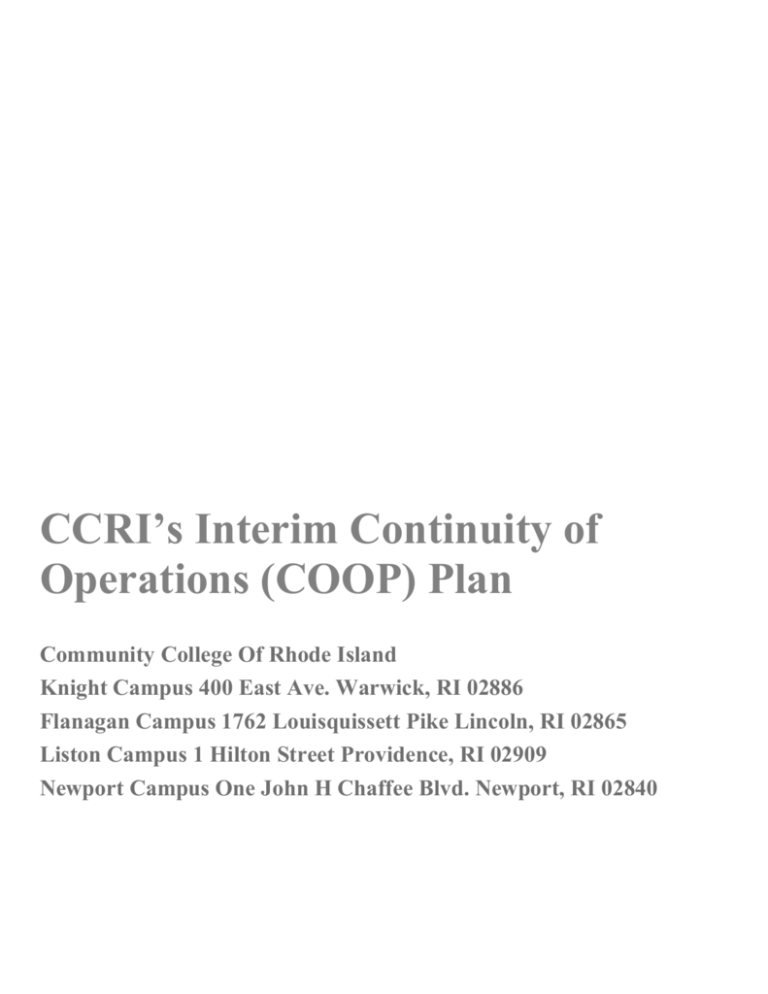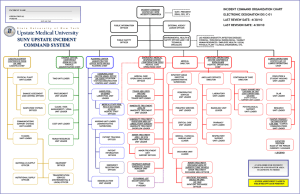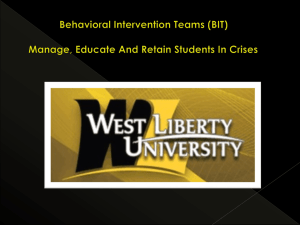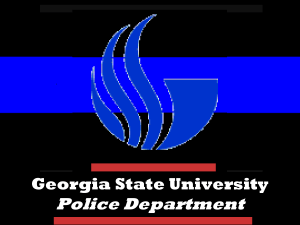VIII. COOP Planning Responsibilities
advertisement

CCRI’s Interim Continuity of Operations (COOP) Plan Community College Of Rhode Island Knight Campus 400 East Ave. Warwick, RI 02886 Flanagan Campus 1762 Louisquissett Pike Lincoln, RI 02865 Liston Campus 1 Hilton Street Providence, RI 02909 Newport Campus One John H Chaffee Blvd. Newport, RI 02840 OVERVIEW This template provides a structure for formulating a Continuity of Operations (COOP) Plan. This template is designed to accompany the Continuity of Operations Template Instructions, which consists of general guidance and sample language for reference. Organizations are encouraged to tailor COOP Plan development to meet their own needs and requirements. The instructions for the template are available from RIEMA. Questions concerning this template can be directed to: John Aucott Homeland Security Director RI Emergency Management Agency 645 New London Ave Cranston, RI 02920 401-946-9996 i TABLE OF CONTENTS I. Executive Summary ............................................................................................................ 2 II. Introduction ......................................................................................................................... 2 III. Purpose................................................................................................................................ 2 IV. Applicability and Scope ...................................................................................................... 3 V. Essential functions .............................................................................................................. 3 VI. Authorities and References ................................................................................................. 4 VII. Concept of Operations ........................................................................................................ 5 A. Phase I: Activation and Relocation ..................................................................................... 5 1. Decision Process ............................................................................................................. 5 2. Alert, Notification, and Implementation Process ............................................................ 5 3. Leadership ....................................................................................................................... 6 B. Phase II: Alternate Facility Operations ............................................................................... 8 1. Mission Critical Systems (under review) ...................................................................... 11 2. Vital Files, Records, and Databases (under review) ..................................................... 11 C. Phase III: Reopening of campus/college........................................................................... 12 VIII. COOP Planning Responsibilities ...................................................................................... 13 IX. Logistics ............................................................................................................................ 13 A. Alternate Location ............................................................................................................ 13 B. Interoperable Communications ......................................................................................... 13 X. Test, Training, and Exercises ............................................................................................ 15 XI. Multi-Year Strategy and program Management Plan (to be developed) .......................... 15 XII. COOP Plan Maintenance .................................................................................................. 15 Annex A: Authorities and References (to be developed) ............................................................. 16 Annex B: Operational Checklists.................................................................................................. 16 Annex C: Alternate Location/Facility Information (to be developed)......................................... 16 Annex D: Maps and Evacuation Routes ...................................................................................... 16 Annex E: Definitions and Acronyms ........................................................................................... 16 ii I. EXECUTIVE SUMMARY The Community College of Rhode Island (CCRI) fulfills its responsibility to educate the public while maintaining a safe, secure environment. CCRI’s COOP Plan is developed to ensure continuity of essential operational and administrative functions for a wide range of emergencies and circumstances. The primary objective of the COOP Plan, in keeping with the mission of CCRI, is to provide for seamless operation of the college and ensure public safety. Those individuals with a stake in this plan are the public at large and the students, staff and faculty of CCRI. The COOP Plan will be available any time that a natural disaster or terrorist attack occurs, as defined by CCRI’S Emergency Response Guide, or a State of Emergency is declared by the Governor or his/her designee. Specific circumstances under which the CCRI COOP Plan shall be employed and include, but are not limited to a natural disasters, acts of terrorism, large scale medical emergencies and sustained loss of power and/or utilities. Although the mission of CCRI is essential to the overall needs of the community it is non-essential to the public’s well being in the case of an emergency or disaster. However there is a need to clearly define orders of succession in all of the college’s “essential function” areas. The Community College of Rhode Island is fortunate and unique in the fact that each of our campuses can operate independent of one another in the case of a disaster that would render one of our campuses inoperable. The key elements of COOP planning for CCRI are continuity of command, Maintaining organizational structure and continuation of essential services which include the areas of security, public safety, and physical plant operation. The COOP Plan, in combination with the National Incident Management System (NIMS), the emergency management policies and strategies of CCRI, provide for a clearly defined chain of command for departmental and facility operations, guidelines and potential resources to prevent interruption of essential services, and procedural guidelines for all aspects of emergency management from initial activation of emergency response through the return to normal operations. II. INTRODUCTION It is essential to the safety of the College’s students, faculty and staff, that a clearly articulated plan is in place to ensure the continuity of operations under all circumstances. Provisions for maintaining uninterrupted security, care, safety and wellbeing of the students, faculty and staff will not be compromised. Emergency planning is fundamental to the College’s operation. The Emergency Response Guide outlines procedures and protocols for a wide range of circumstances, including utility failure, natural disasters, a reduced work force, and facility evacuation. Law enforcement and public safety elements as well as Physical Plant Operations are applied to all emergency planning. Along with the rest of the nation, CCRI has had to expand its emergency planning to reflect the increased threat we all face subsequent to the events of “9/11” and the current activities around the world. 2 Emergency planning at CCRI has always included provisions for primary personnel in all major command and essential services roles. It was once inconceivable that one single act or incident could potentially render the entire executive staff of an organization unable to respond to an emergency. The potential threats that currently exist in recent times have forced all organizations and institutions to develop contingencies to deal with for such circumstances. III. PURPOSE In keeping with Presidential Directive HSPD-5 and State of Rhode Island Executive Order 0410, CCRI is revising its Emergency Response Guide in accordance with the National Incident Management System (NIMS). CCRI does not have resident students on our campuses, making the COOP Plan less complicated. The development of the plan ensures that all critical operations, to include command functions, can be carried out by qualified personnel who are competent in their assigned areas of operation. CCRI’s Emergency Response Guide contains eleven separate reaction plans and operational checklists. In keeping with the Incident Command System, it recognizes that many other state and local agencies may have jurisdictional authority at the college during emergency situations. CCRI is prepared to enact its emergency plans in accordance with the principles of ICS “Incident Command System” when necessary. IV. APPLICABILITY AND SCOPE The COOP Plan is established so that all essential functions of CCRI will continue to operate under any and all circumstances. It ensures that the lines of authority within the institution are clearly developed from the Director (Incident Commander under ICS) on down to the facility or departmental supervisor. While CCRI’s College Police Department consistently functions under paramilitary principles in its daily operations, the COOP Plan delineates a comprehensive line of authority, so that even under the most incapacitating circumstances that the College may face, the essential functions of CCRI will continue to operate. The multi-campus configuration of our college and the fact that all campuses are within ten to fifteen miles from one another, and the functional capabilities of its MIS and Telecommunications operations, the geographic relocation of the CCRI headquarters (or “Command”) can be accomplished relatively seamlessly on any one of the campuses. All CCRI campuses are required to have space and resources that can serve as a command post. The essential executive and administrative functions of the College can be physically established at any one of the campuses in Newport, Warwick, Providence or Lincoln. In the event that no location on the campus where the incident has taken place is a suitable CCRI Command base, the base could be located at any one of our other campus locations. All other campus locations have access to the CCRI network servers 3 V. ESSENTIAL FUNCTIONS The following table illustrates essential functions pertaining to the COOP plan coordination for the Community College of Rhode Island Priority Essential Functions 1 Executive Oversight / Command 2 Security and staffing protocols Food for staff (three days supply) 3 Water (potable & non-potable) Contingencies to sustain for longer time frame VI. 4 Telecommunications 5 Maintenance 6 Information Technology and (MIS) 7 Public Information Officer 8 Human Resources / Payroll AUTHORITIES AND REFERENCES Rhode Island State Police Providence Police and Fire Department Warwick Police and Fire Department Lincoln Police and Fire Department Newport Police and Fire Department Food Services Narragansett Electric Providence, Newport Gas Companies Providence, Kent County and Newport Water Supply Board Rhode Island Emergency Management Agency 4 Rhode Island National Guard Supply Telecommunications VII. CONCEPT OF OPERATIONS In the event of any emergency that may occur at CCRI which exceeds the response capabilities of the College, the Institution will implement a coordinated, systematic response, based on the Federal Emergency Management Agency’s National Incident Management System, to maintain public safety, preserve and protect the safety of students, faculty and staff, and ensure the protection of state property. CCRI’s Emergency Response Guide outlines the scope of authority and span of control for the school’s emergency response. In addition to outlining the above, the Emergency Response Guide contains eleven (11) Emergency Reaction Plans which are intended to serve as checklists for the Incident Commander from the onset of the emergency to its conclusion. Based on the open environment that all CCRI campuses enjoy, there are certain standard operating procedures that are likely to be applicable in all emergency situations such as restricting free movement about the campus, containing the affected area, and accounting for all students, faculty and staff. These checklists are designed to ensure that the appropriate measures are taken at the onset of the incident, and also to serve as an assessment tool for the Incident Commander once an emergency is underway. A. PHASE I: ACTIVATION AND RELOCATION CCRI’s emergency planning contains strategies for continuity of operations and services. Any time that an emergency situation or incident occurs, the paramilitary rank structure of the CCRI Police Department determines who takes initial command of the incident. When an incident escalates to proportions beyond the threshold of normal operations, the Department’s Emergency Response Guide defines the lines of authority for all essential operations. The Emergency Response Guide outlines the activation process for the Department’s Emergency Response. This activation process contains elements of the Department’s COOP Plan in the form of listing successors for all positions that oversee essential services and operations for the College. 1. Decision Process For all emergency incidents which, in the opinion of the Chief of College Police or his designee (ex. shift commander), exceeds facility-based response capabilities CCRI’s Emergency Response Plan will be activated. It is essential that all CCRI personnel responsible for emergency response understand that ICS is a management system that expands and contracts according to the circumstances of the emergency. In any given emergency incident, the highest ranking person at the scene of the 5 emergency (the Incident Commander) has the responsibility and authority to summon the numbers and types of responders that he/she deems necessary to resolve the incident, and to assign and delegate personnel to assume responsibility to contain, isolate, and resolve the emergency. At the onset of the emergency, it is the responsibility of the Incident Commander to request whatever assistance from outside the facility s/he deems appropriate, and notify his/her chain of command. The Incident Commander has the discretion to request specific resources from other facilities, to activate an ICS Security Personnel Response, or, through the Administrative Chain of Command, request activation of a full scale, Management, Tactical and assisting agency response which all of CCRI’s internal assets and the resources of assisting agencies may be used to address an emergency situation. 2. Alert, Notification, and Implementation Process CCRI has specific notification protocols for each level of emergency response. For emergencies that are quickly brought under control or managed utilizing on site resources, (ie. isolated medical emergencies, assaults, medical aid calls, physical plant emergencies causing limited disruption to operations, etc.) College Police portable radios or telephones will be utilized to notify the necessary responders. The chain of authority for managing these types of emergencies is clearly established via the staffing pattern at each of the campus buildings and each respective shift. In the event of an emergency, which by definition, requires the introduction of on duty personnel from other buildings as responders, the affected facility’s shift commander serves as the Incident Commander until relieved by a higher authority, if the magnitude of the situation calls for management personnel to direct the situation. The Incident Commander is generally determined by rank, followed by seniority, unless the senior staff chooses to acquiesce to a less senior staff member based on qualifications or experience. Notifications are established via College Police radio transmission, telephone lines and a public address system serve as a back up means of notification. If an emergency escalates to the highest level, the Chief, Deputy Chief, Dean of Administration, and President of the College have the authority to activate pre-selected personnel be called in as emergency responders. Institutional emergency recall procedures include the use of telephones at any of the College Police Offices, which can also serve as backup location if one College Police Office is determined unsafe or inoperable. The present group notification method is the primary means of notification until the Verizon group notification system is in place. The Verizon Group notification system will be able to deliver a scripted phone message to needed college personnel, identified by the individual activating the system. CCRI is presently working in conjunction with OSHEAN to develop a CISCO (IPICS) system. The IPICS system converts all emergency responders to a common frequency to communicate. CCRI is also in planning with Connect-Ed to expand the school’s existing notification system, automated notification system will broadcasts pertinent information to students, faculty and staff, as well as persons and businesses in the immediate area. 6 3. Leadership a. Orders of Succession Chief of College Police (or in his/her absence, the Deputy Chief) will, at all times, exercise overall authority during the COOP. At onset, a call shall be made to the Governor of the State of Rhode Island and the Rhode Island Emergency Management Agency at 401-946-9996, which is available twenty-four (24) hours per day. A College Emergency Operations Center (EOC) will be established at the College campus where the incident is occurring: Warwick Campus, 400 East Avenue, Warwick RI 02886; Tel Number: 401-825-2109 Providence Campus, 1 Hilton Street, Providence RI 02909; Tel Number: 401-455-6050 Lincoln Campus, 1762 Louisquissett Pike; Lincoln, RI 02865; Tel Number: 401-333-7035 Newport Campus, One John H Chaffee Blvd.; Newport, RI, Tel Number: 401-851-1618 It will be staffed twenty-four (24) hours per day. The ranking incident commander will be in charge. All activities within the area of the emergency will be directed by the Emergency Operation Center. Assisting agencies will establish a chain of command parallel to CCRI’s chain of command at both the EOC and the Institutional Operations Centers. CCRI personnel will work through a chain of command and assisting agency personnel will work through their chain of command. Crossover of authority will take place at the EOC. However, assisting agency staff must be responsive at their respective locations to technical supervision of individual tasks. They should also be responsive to facility administrators at each location. Successors Chief of College Police Deputy Chief of College Police Captain Shift Commanders Dean of Administration b. Delegations of Authority The Incident Commander (IC) is the Chief of College Police. In his/her absence the succession of authority transfers to the Deputy Chief of College Police, Captain, Shift Commander and then to the Dean of Administration. The Deputy Incident Commander is the Deputy Chief of College Police. In his/her absence, the Captain, Shift Commander of the effected Campus, to the Dean of Administration. 7 The Incident Commander and Deputy incident Commander will directly oversee the following Chiefs/sections: Planning Chief: Shift Commander of the effected Campus. In his/her absence the succession of authority transfers to the senior officer, to another pre-designated officer. The planning chief’s duties include oversight of the Emergency responders, and the Records and Identification Unit. Operations Chief: Captain of College Police. In his/her absence, the succession of authority transfers to the affected facility senior officer, to a pre-designated officer from an unaffected facility. The duties of the operations chief include oversight over the affected facility and the Responding Emergency Teams. Logistics Chief: Dean of Administration will act as the Logistics Chief with the succession to pre-designated backup Associate Dean of Administration in their absence. The duties of the logistics chief include oversight of medical, food services, supply, maintenance, telecommunications, management information services (MIS), operations of the non-affected facilities, and the Stress Team (Dean of Student Affairs). Finance / Administrative Chief: The Vice President of Finance. In his/her absence, the succession of authority transfers to the assistant to the Associate Director, to the Assistant Administrative Financial Manager. The duties of the finance/administrative chief include oversight of Financial Resources, the Business Office, and Human Resources. Command Staff (Comprised of three Officers) Liaison Officer will be the Captain of College Police. The succession of authority transfers to a pre-designated unaffected campus. Information Officer will be the Director of Public Relations. Safety Officer will be the Director of Human Resources. The succession of authority transfers to the Environmental Health Coordinator. B. PHASE II: ALTERNATE CAMPUS OPERATIONS The Dean of Administration is required to determine alternate site operations based on the security and safety levels at each of the other campuses, student, faculty and staff needs, security and custodial needs and requirements, medical needs of the students, faculty and staff population, and capacities to assist other campuses. Facility minimum staffing requirements are as follows: TOTAL STAFFING REQUIREMENTS FOR ALL FACILITIES Police Officers 8 Nurses 1 Brass 4 Maintenance Staff 4 All classes will be cancelled for the entirety of the emergency. 8 INDIVIDUAL BUILDING STAFFING REQUIREMENTS Warwick Campus KNIGHT Police Officers 2 Nurses 1 Brass 1 Maintenance Staff 1 All classes will be cancelled for the entirety of the emergency. Providence Campus LISTON Police Officers 2 Nurses 0 Brass 1 Maintenance Staff 1 All classes will be cancelled for the entirety of emergency. Lincoln Campus FLANAGAN Police Officers 2 Nurses 0 Brass 1 Maintenance Staff 1 All classes will be cancelled for the entirety of emergency. Newport Campus Police Officers 2 Nurses 0 Brass 1 Maintenance Staff 1 All classes will be cancelled for the entirety of the emergency. The Administrative staff, College Police Officers and Physical Plant personnel will report to their assigned campuses or an alternate campus as the situation/incident dictates. 9 The CCRI has handled a number of small emergencies over the years. Storms, loss of utilities, job actions, and other emergency situations have all been managed effectively by CCRI personnel. Managers and supervisors in the Department are well versed in operating under adverse conditions. They are immediately able to identify what resources are needed in a given emergency situation and when and where those resources should be obtained. To strengthen the continuity of essential operations, key personnel in the framework of the Department’s Emergency Response Guide and Physical plant operations are being charged with developing operational manuals specific to their areas. These Operation manuals will serve as both references and training resources. 10 1. Mission Critical Systems The following table illustrates mission critical systems, their current locations, and alternate situation sites pertaining to COOP plan coordination for CCRI. System Name Current Location Other Locations Executive Command Warwick Campus Transferable to any campus Food Services Warwick Campus Lincoln, Providence & Newport Campuses Maintenance Warwick Campus Lincoln, Providence & Newport Campuses Information Technologies and Warwick Campus (MIS) Lincoln, Providence & Newport Campuses Telecommunications Warwick Campus Lincoln, Providence & Newport Campuses Records & Identification Warwick Campus Lincoln, Providence & Newport Campuses 2. Vital Files, Records, and Databases The following table illustrates vital student and personnel records, files, and databases pertaining to the COOP plan for the Community College of Rhode Island. Vital File, Record, or Database Student, Faculty Staff Records Student Records Form of Record (e.g., hardcopy, electronic) & Electronic Hardcopy Medical Electronic Hardcopy Emergency Plans Electronic Hardcopy Pre-positioned at Alternate Facility Hand Carried to Alternate Facility * X Backed up at Third Location X X X X * X X X * X CCRI Policies Electronic * X Staff Payroll & Files Electronic * X X X X X 11 Vital File, Record, or Database Form of Record (e.g., hardcopy, electronic) Pre-positioned at Alternate Facility Hand Carried to Alternate Facility Backed up at Third Location Campus Population Hardcopy Counts / Reports Electronic * X X X HVAC Systems** X X X Electronic *All electronic files, records, and databases that are kept on the CCRI network servers are backed up On keeping with best practices to a local hard drive daily. It is stored on the back up drive for one week. It is then put on tape and stored for one month. C. PHASE III: REOPENING OF CAMPUS/COLLEGE Announcement to the fact that emergency has ended Staff and faculty reoccupy campuses Perform emergency count(s) Gather information & reports from personnel and witnesses. Identify and resolve any problems that would prevent a safe return to normal operations (infrastructure, medical, food services, and supplies). Release spare personnel and outside agencies. Return, inventory, clean, inspect all equipment and replenish all supplies. Debriefing and after action report of incident 12 VIII. COOP PLANNING RESPONSIBILITIES The following table illustrates the distribution of responsibilities pertaining to COOP planning for CCRI. Responsibility Position Executive readiness President of College Medical Medical/Nurse Director Financial Resources Vice President of Finance and Administration Medical Records Dean of Students Human Resources Director, Human Resources Logistics Chief of College Police Planning Deputy Chief of College Police Supply Physical Plant Director Facilities & Maintenance Director, Physical Plant Telecommunications Director of Network/Telecommunication Management (MIS) Information System Director, Information Technology Stress Team Dean of Students Facility SOPs Captain of College Police Line staff training Chief of Training IX. A. 1. LOGISTICS ALTERNATE LOCATION Unplanned Emergency Students, faculty and staff will evacuate with only what’s in their immediate possession. (Only essential clothing, eyeglasses, dentures, prosthesis, and footwear are authorized). No other personal property is authorized to be retained by students, faculty and staff during the evacuation. In the event that decontamination efforts are required, all personnel will surrender property in accordance with the directives of the responding Hazardous Materials Unit Officer in 13 Charge (Hazmat OIC). 2. Planned Emergency a. Any necessary evacuation which allows for a timely evacuation under non-lifethreatening circumstances. Those at the Community College of Rhode Island are fortunate that student residents are not an issue. We do not have to plan or consider the need for short or long term housing or food preparation. Temporary housing plans for emergency responders, Campus Police and Physical Plant personnel will be created as necessary. Accommodations will be made for food shower and toilet facilities. Means of Evacuation: 1. Rhode Island Public Transportation Authority Vehicles would be made available for students that do not have their own transportation available for an immediate exit of the college property, additional evacuation plans will include: 2. Assisting transportation agencies Warwick, Providence Lincoln or Newport School Department Bus Transportation B. INTEROPERABLE COMMUNICATIONS (Include GETS, WPS, TPS recommendations and generator information) CCRI is the new host location for the State 800mhz RITERN base station radio. As the host location we have access to two of the radios used to communicate with a number of public safety organization throughout the state. The use of this radio system gives us access to facilitate interagency operability to State and local public safety agencies. As previously stated, CCRI is in the planning with CISCO for an IP communication system that as well as the state 800mhz radio allows interagency operability to State and local public safety agencies, as will the IP communications system. CCRI also has the use of Verizon cellular telephones, 4 of which are assigned to individual campuses of the College Police Department and a number of cellular phones are distributed among all executive level administrative personnel and at least one physical plant manager at each campus. These cellular phones may be utilized by Administration, Physical Plant and or College Police Officers in lieu of portable radios. These would be available for deployment to facilities and personnel as needed. 14 All Campuses have generator backup. Major functions that are lost when a facility goes to generator power vary. As a general rule, some of the lost capabilities include: Majority of lighting Most computers Cameras Heating and Air Conditioning Majority of electrical outlets Specific items that are powered by generator are security systems, fire alarms, emergency lighting, and elevators, food refers an hazardous material waste site. Each campus has industrial size backup generators, but should the need arise; there are rentals available of the size that could be acquired within a twenty-four (24) timeframe. All generators are diesel or propane operated, and there is thirty (30) to seventy-two (72) supply of fuel depending on which campus the generators are located. There is a contract in place to refuel all generators, and a twenty-four (24) turn around for refueling requests. X. TEST, TRAINING, AND EXERCISES CCRI is in the process of training all College Police Officers to be in compliance with NIMS, by September 2006. Each of our officers are trained to be first responders, as well as first aid and AED trained. Currently CCRI policy required that facilities regularly conduct fire drills, and other emergency drills are conducted on a quarterly basis. XI. MULTI-YEAR STRATEGY AND PROGRAM MANAGEMENT PLAN Text Here XII. COOP PLAN MAINTENANCE CCRI shall, at a minimum, review its COOP Plan as required, in conjunction with its Emergency Response Guide, and be updated if there are significant personnel or operational system changes occur within the Department. 15 Annex A: Authorities and References Text Here Annex B: Operational Checklists See the Emergency Response Guide on the department’s website (www.ccri.edu/campuspolice). Annex C: Alternate Location/Facility Information Text Here Annex D: Maps and Evacuation Routes See the Emergency Response Guide on the department’s website (www.ccri.edu/campuspolice). Annex E: Definitions and Acronyms COOP – Continuity of Operations EOC - Emergency Operations Center HAZMAT - Hazardous Material IAP - Incident Action Plan IC - Incident Commander ICP - Incident Command Post ICS - Incident Command System IC or UC - Incident Command or Unified Command IMT - Incident Management Team MIS – Management Information System NIMS - National Incident Management System PIO - Public Information Officer RIEMA – Rhode Island Emergency Management Agency RING – Rhode Island National Guard RISP - Rhode Island State Police UC – Unified Command SO - Safety Officer SOP – Standard Operating Procedure 16








